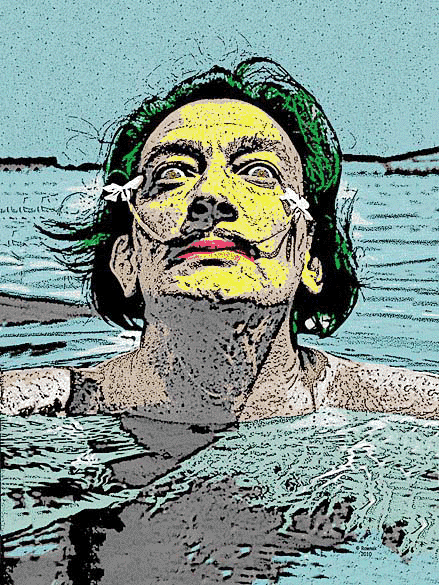
Want
me to do a pop-art portrait for you? Send me an EMAIL and
lets talk!
Salvador Dali Biography
--------------------------------------------------------------------------------
Dalí,
Salvador (1904-89): Spanish painter, sculptor, graphic artist, and designer.
After passing through phases of Cubism, Futurism and Metaphysical painting,
he joined the Surrealists in 1929 and his talent for self-publicity rapidly
made him the most famous representative of the movement. Throughout his
life he cultivated eccentricity and exhibitionism (one of his most famous
acts was appearing in a diving suit at the opening of the London Surrealist
exhibition in 1936), claiming that this was the source of his creative energy.
He took over the Surrealist theory of automatism but transformed it into
a more positive method which he named `critical paranoia'. According to
this theory one should cultivate genuine delusion as in clinical paranoia
while remaining residually aware at the back of one's mind that the control
of the reason and will has been deliberately suspended. He claimed that
this method should be used not only in artistic and poetical creation but
also in the affairs of daily life. His paintings employed a meticulous academic
technique that was contradicted by the unreal `dream' space he depicted
and by the strangely hallucinatory characters of his imagery. He described
his pictures as `hand-painted dream photographs' and had certain favorite
and recurring images, such as the human figure with half-open drawers protruding
from it, burning giraffes, and watches bent and flowing as if made from
melting wax (The Persistence of Memory, MOMA, New York; 1931).
In 1937 Dalí visited Italy and adopted a more traditional style;
this together with his political views (he was a supporter of General Franco)
led Breton to expel him from the Surrealist ranks. He moved to the USA in
1940 and remained there until 1955. During this time he devoted himself
largely to self-publicity; his paintings were often on religious themes
(The Crucifixion of St John of the Cross, Glasgow Art Gallery, 1951), although
sexual subjects and pictures centring on his wife Gala were also continuing
preoccupations. In 1955 he returned to Spain and in old age became a recluse.
Apart from painting, Dalí's output included sculpture, book illustration, jewellery design, and work for the theatre. In collaboration with the director Luis Buñuel he also made the first Surrealist films---Un chien andalou (1929) and L'Age d'or (1930)---and he contributed a dream sequence to Alfred Hitchcock's Spellbound (1945). He also wrote a novel, Hidden Faces (1944) and several volumes of flamboyant autobiography. Although he is undoubtedly one of the most famous artists of the 20th century, his status is controversial; many critics consider that he did little if anything of consequence after his classic Surrealist works of the 1930s. There are museums devoted to Dalí's work in Figueras, his home town in Spain, and in St Petersburg in Florida.
1904: Salvador Felipe Jacinto Dalí was born on May, 11th in Figueras, Catalonia, Spain.
1917: He started to visit the School of Art. First paintings.
1918: First small exhibition in the Theatre.
1921-25: Went to Academy of Arts in Madrid. Conflicts with his teachers.
1925: First stand-alone exibition of Dalí at the Galery of Dalmau.
1926-28: Early explorations of the Surrealism. Dalí in Cadaqués 1927
1929: Gala went into his life. Joined the group of Surrealists in 1930 Gala 1927, and Dalí 1929
1934-37: Dalí had his paranoid-critic-epoch. Dalí and Gala in 1937
1941-44: "Avida Dollars" in America.
1945-49: Dalí the Classic. Dalí and his Daddy in Cadaqués 1948
1950-65: His mystic period. He wrote several books (The secret life of Salvador Dalí).
1963-78: Dalí the Divine - Dalí and the Science.
1979-83: Theory of Disaster.
1982: Gala died.
1989: Dalí, Jan. 23th, died.
